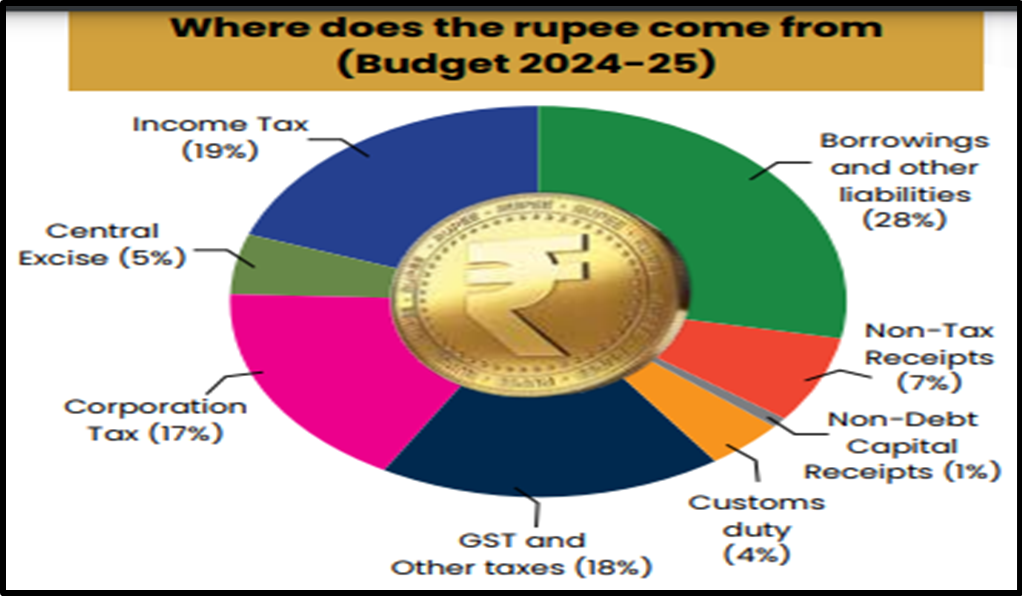“BUDGET 2024-25: CLAIMS, CONTRADICTIONS, AND ECONOMIC REALITIES”
Syllabus:
GS-3: Government Budgeting
Focus:
The Budget 2024-25, presented by Finance Minister Ms. Nirmala Sitharaman, has sparked widespread debate due to its claims of increased expenditure, disputed unemployment figures, and handling of inflation. The contrasting data and public response have brought these economic issues to the forefront of national discourse.
source:wordpress
Increased Government Spending:
- Claims of Increased Expenditure: The FM argued that the government is spending more money under each head of expenditure, indicating good governance and benefiting all sections of people.
- Comparison with Previous Years: She presented numbers showing increased expenditure compared to 2013-14, 2019-20, and 2023-24.
- Real vs. Nominal Terms: The FM’s numbers were in gross prices, not constant prices, which can be misleading.
- Unspent Allocations: Several allocated funds were not spent in 2023-24, with no explanation provided.
- Proportion of GDP: Enhanced expenditure claims are only relevant if expressed as a proportion of total expenditure or GDP.
| Understanding Union Budget:
Definition:
Revenue Budget:
Capital Budget:
Key Features:
Interim Budget 2024 Highlights
Performance of Key Schemes:
|
Unemployment Issues:
- Government’s Stance: The FM claimed that the government’s policy of saksham, swatantra, and samarth had reduced unemployment to 3.2%.
- Contradictory Data: Government reports showed job creation, but CMIE data estimated current unemployment at 9.2%.
- Disproportionate Job Applications: The high ratio of applicants to available jobs, such as UP Police Constable Recruitment and SSC, contradicts claims of low unemployment.
- Highly Qualified Applicants: Engineers, management graduates, and post-graduates applying for constable or clerk positions indicate severe underemployment.
- Real-Life Assessment: The FM suggested walking the streets to understand the actual unemployment situation.
Inflation Concerns:
- Historical Comparison: The FM criticised the UPA government’s high double-digit inflation between 2009 and 2013, attributing it to poor economic management.
- Current Inflation Rates: She did not address current inflation issues, with prices of essential commodities rising significantly.
- Wages Stagnation: Worker wages have stagnated over the last six years, worsening the inflation impact.
- Lack of Mitigation Measures: No proposals were made to reduce administered prices, taxes, or increase minimum wages to mitigate inflation.
- RBI’s Bank Rate: Despite claims of admirable inflation management, the RBI has kept the bank rate at 6.5% for 13 months, indicating persistent inflation concerns.
The Budget’s Reception:
- Cold Reception: The Budget received a cold reception from the average citizen, reflecting widespread scepticism and caution.
- Cheerleaders’ Response: Even traditional supporters of the government were cautious and sceptical about the Budget’s impact.
- Lack of New Ideas: The FM’s reply lacked new ideas to address pressing economic issues like inflation and unemployment.
- Public Sentiment: The FM’s dismissive approach did not resonate with the public’s current economic realities.
- Unchanged Perceptions: At the end of the FM’s reply, there was no significant change in the understanding or perception of the Budget’s impact.
Challenges:
- High Costs: The prohibitive costs of targeted cancer therapies remain a significant barrier for many patients, limiting access to life-saving treatments.
- Limited Insurance Coverage: Many insurance policies do not fully cover modern cancer treatments, leaving patients to bear substantial out-of-pocket expenses.
- Accessibility: Geographic and economic disparities mean that advanced cancer treatments are not equally accessible to all patients.
- Side Effects: Even with newer drugs, managing side effects remains a challenge, necessitating additional therapies and costs.
- Awareness: There is a lack of awareness about affordable generic alternatives and patient support programs.
Way Forward:
- Subsidies: Increased government subsidies and funding for cancer treatments can help reduce the financial burden on patients.
- Insurance Reforms: Expanding insurance coverage to include modern cancer treatments can make them more affordable and accessible.
- Telemedicine: Utilising telemedicine can improve access to cancer care, especially in remote and underserved areas.
- Education: Public awareness campaigns about generic drugs and support programs can help more patients access affordable treatments.
- Research: Investing in research for cost-effective cancer treatments and management of side effects can improve patient outcomes.
Conclusion:
The FM’s Budget presentation and subsequent replies have highlighted significant issues regarding government spending, unemployment, and inflation. While efforts to increase expenditure are evident, the real impact on the economy and citizens remains debatable. Addressing these challenges requires a multifaceted approach involving policy changes, public awareness, and targeted reforms.
Source: The Hindu
Mains Practice Question:
Critically analyse the claims made by the Finance Minister in the Budget 2024-25 regarding increased expenditure, unemployment reduction, and inflation management. Discuss the underlying challenges and suggest measures to address these issues effectively. (250 words)




